ASM Metals HandBook Vol. 14 - Forming and Forging
Подождите немного. Документ загружается.


Reinforced concrete has been considered for the construction of dies large enough to exceed the machining capabilities of
all-metal dies. The ease of producing large concrete dies is a primary advantage. Disadvantages include the low tensile
strength of concrete.
Plaster has been used for one-shot dies. Because the rate of loading is very fast, the shape of the brittle die material is
transferred to the metal surface before the die crumbles. Better results are produced if a plaster die is contained in a metal
case so that the plaster is loaded in compression to the greatest extent possible. The case should be cylindrical to minimize
stress concentration.
Materials for Composite Dies. Glass cloth/epoxy resin laminates backed with either concrete or a sand, gravel, and
epoxy mix are used. This system is usually contained in a low-carbon steel container, such as A36 pipe, for cylindrical
systems. Where heavy loading is encountered, the life of a plastic laminate is about 25 pieces before it begins to crack and
must be replaced. Because replacement cost is low, this is not a serious disadvantage.
Concrete has been used for the die working face when only one shot is needed. Ice dies have been successfully used on
domes as large as 3.05 m (120 in.) in diameter.
The use of plastic laminates in zinc alloy dies of complex shapes will provide a considerable savings in die sinking time.
The body of the zinc alloy die is cast roughly to shape, and a plastic laminate made from a plaster matrix is then seated in
the die by backfilling with a resilient plastic. Dies have also been made from laminate plates and conventionally formed
thick-wall shells.
References cited in this section
2.
J.S. Rinehart and J. Pearson, Explosive Working of Metals, Macmillan, 1963, p 19-20, 263-266
3.
A.E. Doherty, Applications of Commercial Explosives to Production of HERF Parts, in
Proceedings of the 9th
International Conference on High-Energy Rate Fabrication, 1986, p 246-250
Explosive Forming
Revised by A.E. Doherty, Explosive Fabricators, Inc.
Transmission Mediums
Most of the early work in explosive forming was done in air, which provided very high peak pressures for very short
periods--usually a few microseconds. Consequently, the total impulse available for forming was less than that in a liquid
medium, which provides slightly greater confinement of the charge and higher efficiency in terms of total impulse. The
size of charge needed for forming a given part in water is approximately 80% smaller than that needed if the art were
formed in air.
Liquids. Water is one of the best media for explosive forming because it is readily available in most locations,
inexpensive to use, and produces excellent results. The energy absorbed by a medium is a direct function of its density;
therefore, considerably more energy might be lost by waves transmitted through a liquid than through air. This loss of
energy, however, is more than compensated for by the additional confinement of the explosive charge and the lengthening
of the pulse due to the trapped energy. The net result is an increase in total impulse available in a liquid over that
transmitted in a gas for the same charge size and standoff distance. When a charge is confined in a liquid medium and the
charge is far enough from the surface of the water, several pulses can be obtained as a result of the overexpansion and
overcompression of the gas bubble from the explosive charge. The greater confinement of the explosive by the water
evens out the pulse distribution and maintains a positive pressure for a period of milliseconds. Figure 9 shows pressure
differences between water and air media, at various standoff distances, using a 1.8 kg (4 lb) charge of TNT.
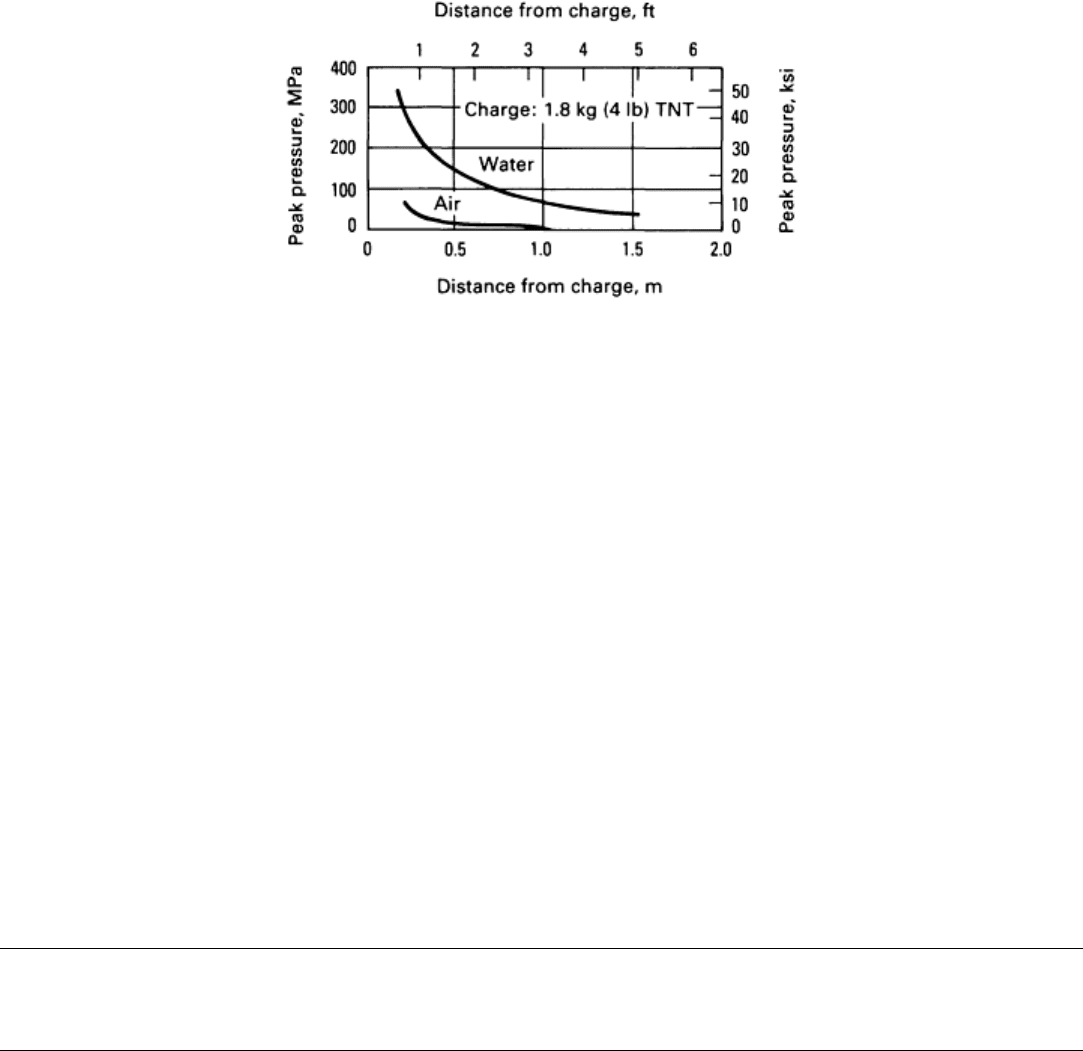
Fig. 9 Peak pressure versus standoff distance for explosive charges fired in air and water.
Other liquids, such as oil, have been successfully used as transmission media. Depending on their densities, they perform
in the same general manner as water, but water is usually preferred because of easier handling. Higher-density liquids,
such as mercury, are too expensive for general use.
Solid media, in the form of rubber sheets, cast plastics, or even metals, are sometimes used in explosive forming.
Plastics and rubber improve the formability of some metals. The use of a plastic transmission medium has proved
especially helpful in the close-tolerance sizing of tubing details.
Solid media afford some protection to the surface of the part being formed. Sometimes, in liquid media or in air, small
slivers of metal projected from the blasting cap or from wire or other material used to attach the charge may strike the
surface of the blank and cause scrap. Difficulty is also sometimes encountered because of slight irregularities in the shape
of the explosive charge, which cause the formation of jets. The jet effect is smaller under water and is normally
troublesome only at very small standoff distances. Perhaps one of the most beneficial characteristics of a solid medium is
the uniform distribution of pressure over the surface of the part being formed.
The explosive forming of heated metals demands the use of some inexpensive medium that will maintain its
characteristics at relatively high temperature and will not transmit much heat to the explosive charge. Several materials,
including sand and small glass beads, have been used for this purpose. If sand is used, some buffer material should be
placed over the blank to prevent the sand from embedding in the work metal or marking the surface.
Explosive Forming
Revised by A.E. Doherty, Explosive Fabricators, Inc.
Shock-Wave Transmission
Shock waves travel through a medium at the speed of sound. When a minimum of energy loss is desired at an interface
between two different media, they should be selected to have a close acoustical impedance match. The acoustical
impedance is a function of the density of the medium; therefore, as a first approximation, matching the densities of the
media helps to increase the efficiency of the system.
Figure 10 shows the effect on the depth of draw of placing an intermediate medium, such as a sheet of rubber, over a
blank. The increase in rubber thickness lowers the maximum depth of draw a given explosive charge will produce, but it
may increase the overall depth of draw the piece will tolerate because of the improved distribution of forming stresses on
the work metal. The use of a solid intermediate medium allows more material to draw from under the blankholder without
wrinkling and without fracturing the cup at the apex.
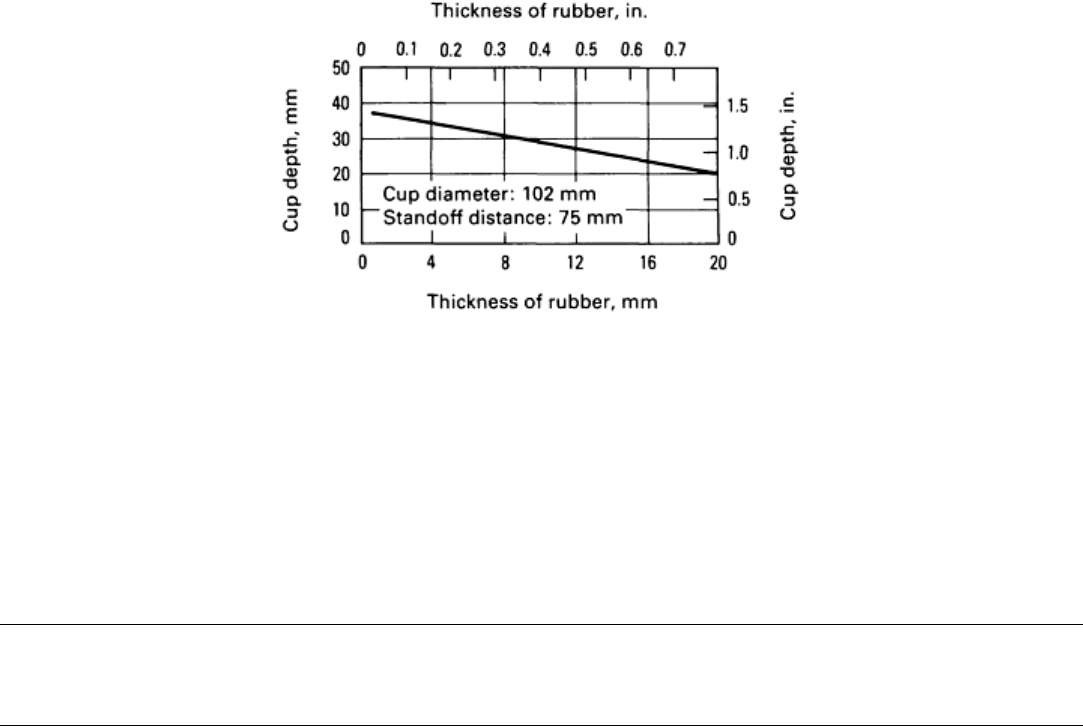
Fig. 10
Effect of thickness of rubber pad placed on blank on depth of draw of a 1.63 mm (0.064 in.) thick PH
15-7 Mo stainless steel cup in explosive forming with 1520 mm (60 in.) of 100 grain Primacord.
The same reasoning is applicable to the impedance between the explosive charge and the medium in which it is detonated.
By obtaining a reasonable impedance match between the explosive and the medium, only weak reflections occur at the
surface of the medium container. If the container walls are shaped properly, the reflections can be used to reinforce the
shock wave that strikes the workpiece. They can also be directed to areas of the workpiece that need greater amounts of
energy for forming.
Explosive Forming
Revised by A.E. Doherty, Explosive Fabricators, Inc.
Forming of Sheet
Explosive forming has been most extensively used to produce parts from sheet metal. For concentric shapes, the tooling
and charge placement are relatively simple, and only minimal experience is needed to produce acceptable parts.
Nonconcentric shapes, however, such as beaded panels, electrode forms, and other asymmetrical shapes, involve
techniques using uneven force distributions, shock-wave reflectors, and shaped charges.
Tooling Considerations. For concentric parts, fairly simple techniques such as casting or turning can be used for the
production of tools. The more complex dies used for nonconcentric parts necessitate hand finishing or profile milling.
Special features can be incorporated into dies to control metal deformation and to minimize buckling.
In simple drawing operations, buckling is prevented by the pressure applied to a blankholder. With concentric parts, an
equal blankholder pressure is applied around the circumference; with nonconcentric parts, variations in blankholder
pressure are needed to accommodate variations in depth of draw. Pressures can be estimated for concentric shapes, but a
trial-and-error system must be used to establish the pressure patterns for nonconcentric shapes. In such systems, the
blankholder pressure for the minimum depth of draw should be 2 to 4% more than for areas of maximum draw. Control of
metal movement during forming can also be accomplished by using a bead around the die to induce more friction between
the blank and die. Another method is to notch the blank perimeter to reduce compression forces. This method is much less
flexible, particularly when a trial-and-error approach is used in the initial forming. The forming of thin sheet metals can
be assisted by sandwiching the blank between two low-carbon sheets to increase the cross section.
Tolerances as close as ±0.025 mm (±0.001 in.) have been met on small parts by explosive forming. However, working
tolerances are generally ±0.25 mm (±0.010 in.). Variations are directly related to the amount of pressure applied in the
forming operation. The use of plastic or rubber fillers over parts also has considerable bearing on the variations in
workpieces. Because filler materials decrease the total pressure imposed on the part but maintain the pressure for a longer
period of time, the increase in total impulse improves conformation to the die and minimizes springback. There are few

applications in which explosive forming in steel dies cannot equal or better the dimensional stability of conventional
forming.
Placement of Explosive Charges. Explosive-forming operations usually require that the charges be at some standoff
distance from the parts to be formed; a contact charge supplies a peak pressure so high that the blank may be ruptured.
Positioning of the explosive charges can be performed by a number of techniques, provided the following conditions are
met:
• The method of positioning should be substantial enough that immersion i
n a water tank for firing will not displace
the charge
• The rigging for the charge should not break into flying projectiles that might damage the workpiece
To meet these requirements, various types of rigging have been used. For large parts, small-gage wire is used and is
generally retrieved with the die. For smaller parts, masking tape is normally preferred for locating the charge because it is
easy to handle. Permanent steel rigging can also be used if the charge is separated from the rigging by at least 50 mm (2
in.). Cardboard tubes work well for separating the charge from the rigging if the tube is not immersed in the water longer
than 5 min before the charge is fired. For longer immersion times, the tube should be sprayed with a plastic coating.
It is often possible to obtain the same results with different types of charges. For example, tank ends can be formed with
cylindrical and spherical charges or with an equal weight of Primacord wrapped on a cardboard tube. Similar results are
obtained if the diameter of the Primacord does not exceed twice the diameter of the solid cylindrical charge.
Consequently, when the supply of one type of explosive has been depleted, it is often possible to substitute another type
that is on hand.
Special shapes of explosive charge are generally needed for the forming of nonconcentric shapes. The development of a
special charge is difficult, and the shape is usually made by trial-and-error tests. Energy transmission to the part can also
be varied through the use of a rubber blanket covering surface areas that need the least forming. The most prevalent
technique involves the use of several charges to work the metal into the die in steps.
Shock-wave reflectors are suitable for producing parts that need a deeper draw in one particular region. However, these
reflectors become very complicated if there is more than one such region in a part.
Economics of Explosive Sheet Forming. Simple shapes that are readily formed by conventional methods should
not be considered for explosive forming; no economic advantage will be realized. More complex shapes, as well as metals
with special properties (such as the work-hardening stainless steels), lend themselves to explosive forming. Size must also
be taken into account; explosive forming can produce extremely large items that would be impractical to form by
conventional methods.
Cost comparisons for fabricating parts by both explosive and conventional forming methods require sufficient quantities
to establish cost information. The number of pieces to be produced affects the relative economy. Although explosive
forming is often applicable only to short production runs, as many as 20,000 pieces have been produced competitively by
explosive forming.
Explosive Forming
Revised by A.E. Doherty, Explosive Fabricators, Inc.
Forming of Plate
The explosive forming of metal plate has been practical because presses large enough to form heavy plate are generally
not available. Economic advantages are realized when a forming operation, prior to the machining of thick parts, can
reduce the subsequent machining time and the weight of raw material required. Explosives have been used to pierce holes
in heavy shapes. This operation requires the use of a wave guide, with appropriately positioned and sized holes, over the
workpiece.
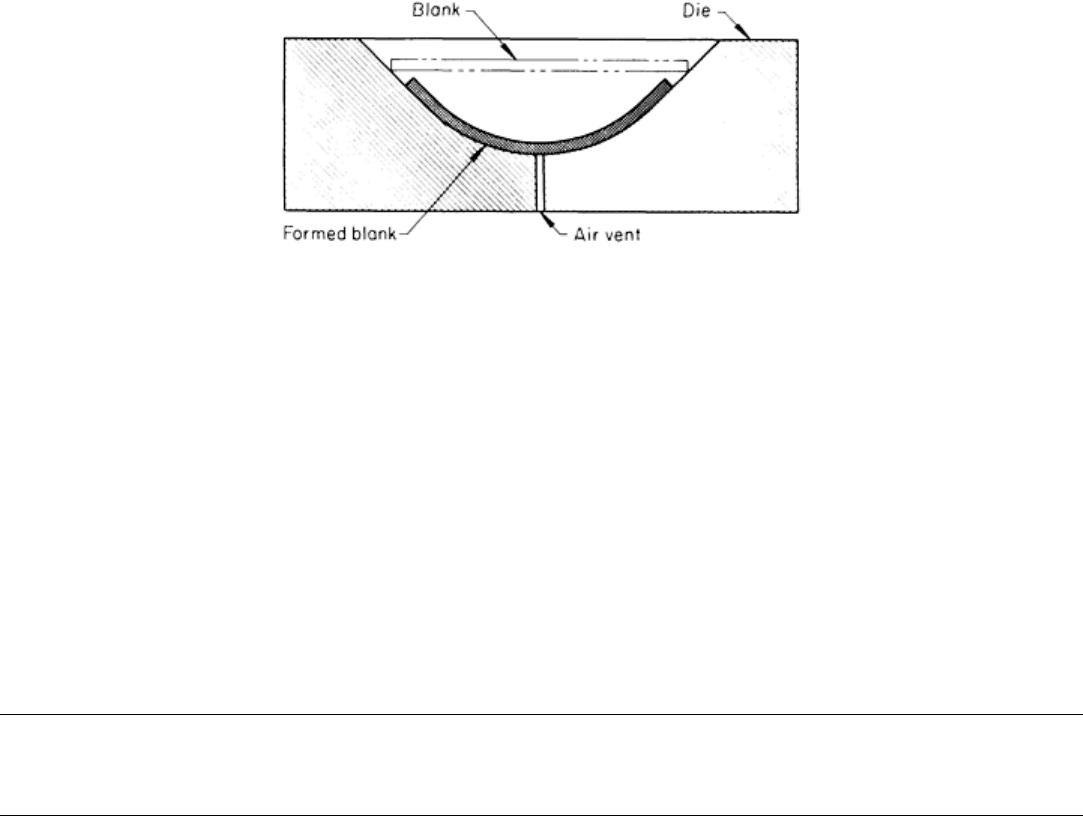
Tooling Considerations. To support the higher loads required for the explosive forming of metal plate, the tooling
must be of heavier construction than that used in sheet forming. Plates are usually not formed to close tolerances,
particularly because they are often machined in a subsequent operation. Forming is generally done in free-forming dies
such as the one shown in Fig. 11.
Fig. 11 Tapered-entrance die used for the explosive forming of plate without a blankholder.
Tolerances that can be met in explosive-formed plate materials are the same as those usually applied in the explosive
forming of sheet metal, that is ±0.25 mm (±0.010 in.). Considerably greater tolerances than this are usually allowed on
parts that are to be subsequently machined. With free-formed plate materials, variations as great as ±6.35 mm (±0.250 in.)
have been considered acceptable.
Placement of explosive charges for plate forming is similar to that for sheet forming, except for the scaled-up size
of the tooling, workpiece, and explosive charges. Because water is the preferred transmission medium in these operations,
the operations must be performed in large water tanks, or if firing is aboveground, a large water bag can be used. In each
approach, the explosive energy is transmitted to the workpiece through water.
Because of the relatively simple shapes involved in plate forming, charge shapes and placement are less complex.
Centrally located charges and ring charges positioned at the desired standoff distances are usually used.
Explosive Forming
Revised by A.E. Doherty, Explosive Fabricators, Inc.
Forming of Tubes
Explosive forces have been successfully used in tube-forming operations. This process has allowed the formation of many
unique tubular shapes by beading and bulging the initial workpieces in selected areas.
Tooling Considerations. To facilitate removal of the completed tubular workpieces, it is necessary to use either split
dies or split tapered die inserts, depending on the particular part to be formed. The use of split dies makes evacuation
more difficult than with single dies in that rubber seals are necessary between the die halves. The parting line between the
die segments will often leave undesirable marks on the formed parts. This marking effect can be lessened by reducing the
explosive charge and increasing the number of shots or by increasing the clamping forces on the die halves.
Some control of the amount of bulging can be achieved through the use of end plugs to apply some restraining force to
prevent drawing from the ends of the tube. This precaution can be critical in thin-gage tubing, which may wrinkle if the
ends of the tube are not restrained.
Shock-wave reflectors can be incorporated into the tooling for explosive forming. They find applications in tooling for
nonconcentric shapes or where reentrant angles are desired. With the use of special reflectors, the charge can be placed at
one end of the tube, and a reflector can be placed inside the tube to concentrate the shock wave in certain areas. Very
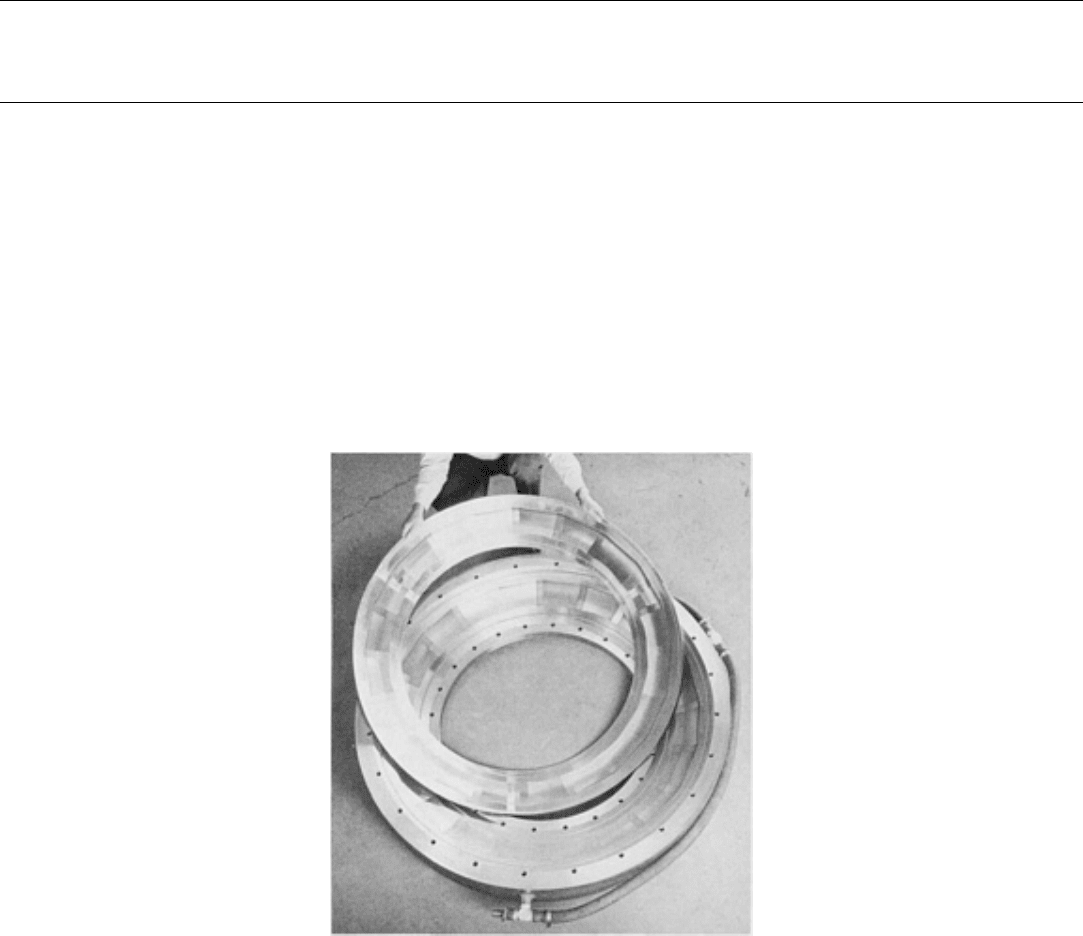
large bulges (350% of tube diameter) have been produced with the use of reflectors, intermediate anneals, and step-
forming operations. The reflectors can vary considerably in design, ranging from a solid filler with an angled cut (to
concentrate the energy on one side of the tube) to exponential shapes for reentrant angles.
Tolerances as small as ±0.025 mm (±0.001 in.) have been held in the forming of small-diameter tubes, but tolerances of
the order of ±0.25 mm (±0.010 in.) are more generally accepted. Extremely close tolerances demand the construction of
heavy, accurate dies that will withstand repeated heavy loading in the production of the desired parts.
Placement of Explosive Charges. The setup for forming generally requires the use of line charges placed on the
centerline of the tube. Alignment of the charge is critical because the tube provides some reflective characteristics to the
shock wave, and misalignment can cause higher pressures in the side of the tube closest to the charge. A rigid plastic tube
can be used to cover the explosive charge and to keep it in line.
Normally, a die is necessary when a specific contour is wanted. Simple bulges can be formed in heavy-wall tubes without
a die, but tolerances cannot be held closely on the diameter or on the contour of the bulge.
Application. The sound-suppressor tubes used on all commercial jet aircraft represent an application that has involved
the production of more than 10,000 pieces. The main economic advantage in this application is derived from the close
tolerances that can be held, as well as the elimination of brazing and other manual operations normally required for the
assembly of conventionally formed tubes.
Explosive Forming
Revised by A.E. Doherty, Explosive Fabricators, Inc.
Forming of Welded Sheet Metal Preforms
Explosive forming has been used in the forming of components from welded preforms. Such preforms are necessary
when the initial tube size is larger than that obtainable commercially or when a specialized starting shape is needed.
Because subsequent forming operations will be conducted, it is necessary that good-quality ductile welds be made in
preform fabrication. Generally, the welds are planished, and the preforms are annealed prior to forming. In addition, when
possible, the welds are located in areas where minimal stretching is expected in order to reduce the possibility of weld
failure during forming. Figures 12 and 13 show typical aircraft components that were explosively formed from welded
sheet metal preforms.
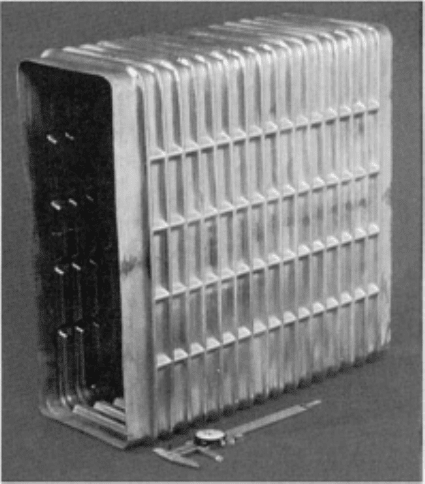
Fig. 12 Aircraft cooling coil that was explosively formed from a welded sheet metal preform. The finished p
art
measures 152 × 457 × 457 mm (6 × 18 × 18 in.) and was fabricated from 1.57 mm (0.062 in.) thick
aluminum. Courtesy of Explosive Fabricators, Inc.
Fig. 13
Jet engine afterburner component, explosively formed from a welded sheet metal preform that has a
914 mm (36 in.) minor diameter and a 1015 mm (40 in.) major diameter. The 0.89 mm (0.035 in.) thick
Waspalloy workpiece utilized the 4340 steel die, on which it rests, in its fabrication.
Courtesy of Explosive
Fabricators, Inc.
Tooling Considerations. The size of part may limit the use of split dies and may limit the process to applications in
which natural draft will permit removal of the part from the die. No other special considerations are necessary for tools
except for the forming of thin parts that may wrinkle when a vacuum is applied between the preform and the die.
Tolerances for parts that are explosive formed from welded sheet can be held to ±0.25 mm (±0.010 in.), although a
more practical tolerance of ±0.81 mm (±0.032 in.) is normally specified. The higher forces that would be necessary to
meet closer tolerances would shorten die life and increase die costs for a given production run. Close tolerances also
require a higher degree of weld finishing prior to forming.
Placement of Explosive Charges. The type and placement of explosive charges in forming welded sheet assemblies
depend on the final shape of the part desired. Line charges positioned at the axis of the assembly are used for long right-
cylindrical shapes. With a cone-shaped part, a point charge located near the base of the cone may be preferable.
Generally, the same type of explosive system is used in all forming operations regardless of blank construction.
Economics of Forming Welded Assemblies. The economic advantages that may be realized in the explosive
forming of welded sheet metal assemblies depend on the complexity of the part design and the number and type of
operations needed in conventional fabrication. In addition, the characteristics of the work metal, such as ease of forming,
welding, and machining, will influence the comparison. In one case, the explosive forming of a 787 mm (31 in.) long
aircraft skin section having 305 and 127 mm (12 and 5 in.) diam ends and made from two aluminum alloys (6061 and
5086) resulted in a savings of 38% per piece over the conventional bulging method, while a savings of only 12% per
piece was realized using the conventional shear-spinning method instead of the conventional bulging forming method.

Explosive Forming
Revised by A.E. Doherty, Explosive Fabricators, Inc.
Explosive Forming of Heated Blanks
Refractory metals such as tungsten are explosive formed with better results when the blanks are heated. The arrangement
shown in Fig. 14 was used to form a dome from tungsten sheet that was heated to 675 °C (1250 °F). Molten aluminum
was used as the transmission medium. The explosive, a 0.012 kg (0.026 lb) charge of composition C-4 plastic demolition
explosive (detonation velocity: 8050 m/s, or 26,400 ft/s; supplier: U.S. Government) was protected by an insulated tube to
avoid premature explosion. The die was constructed from 4130 steel. A dome 114 mm (4.5 in.) in diameter by 25 mm (1
in.) high was formed within a tolerance of ±0.076 mm (±0.003 in.) in one shot.
Fig. 14 Use of molten aluminum as a medium in the elevated-
temperature explosive forming of tungsten.
Dimensions given in inches.
Explosive Forming
Revised by A.E. Doherty, Explosive Fabricators, Inc.
Formability
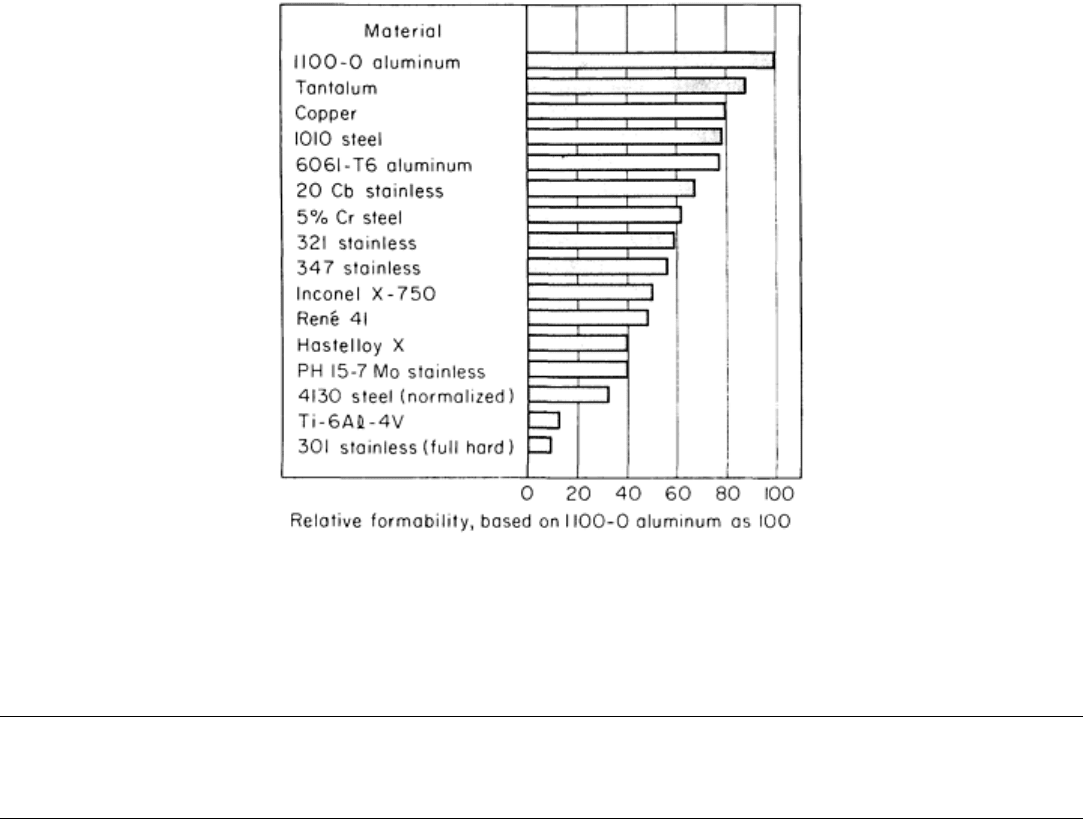
In normal explosive-forming operations, the major characteristics of the work metal that determine formability are
ductility and toughness. It is general practice not to exceed the elongation, as determined by tension testing, in forming a
part from the same metal. Toughness criteria cannot be as readily applied, because forming represents biaxial and triaxial
stressing, as compared with uniaxial stressing in the tension test. In addition, the design of tooling can influence the
apparent formability of a material.
Comparisons of formability of various materials by explosive forming are subject to the particular experimental design
under which they are tested. As a result, absolute values of formability are not obtained, but relative behavior for use in
other explosive forming operations can be established. A comparison of the formability of some metals, using annealed
aluminum alloy 1100 as a basis, is shown in Fig. 15. The apparent formabilities shown can be increased through modified
tooling design in other operations. Increasing the forming temperature will also provide obvious forming advantages.
Fig. 15 Formability of various metals by explosive forming relative to that of aluminum alloy 1100-
O. The
comparison is based on the forming of 0.81 mm (0.032 in.) thick material with explosive at 381 mm (15 in.)
standoff distance. All metals were annealed unless otherwise indicated.
Explosive Forming
Revised by A.E. Doherty, Explosive Fabricators, Inc.
Safety
In and around an explosive-forming facility, any fire- or spark-producing equipment must be eliminated. Precautions
should include the collection of all matches and lighters from any person entering any building where explosives are
present. During operations, only persons absolutely necessary for carrying out the operations should be present.
Misfires during an operation are extremely hazardous and time consuming. Precautions should be taken to ensure that an
electrical short circuit does not occur during the immersion of the setup for firing in the water tank. Incorrect placement or
improper size of the blasting cap may cause failure of the charge to explode when the cap detonates.

Precautions to be taken if the firing circuit has been energized and the charge does not go off include a check of the
continuity of the circuit. If the circuit is good, another attempt should be made to fire the charge. If this fails, the firing
circuit should be disconnected from the power source and the power source tested for proper output. If no failure is found
in the power source, the lead wires in the firing circuit can be inspected visually from a distance to determine if any shorts
have occurred. Under no circumstances should the charge be brought to the surface for examination until 15 min has
elapsed from the last time attempts were made to fire the charge. All personnel should leave the area during this waiting
period. After the specified time has elapsed, the charge should be brought to the surface and a new cap installed. When
defective blasting caps are found, they should be destroyed with any other scrap explosive at the close of operations for
each working day.
Explosive Forming
Revised by A.E. Doherty, Explosive Fabricators, Inc.
References
1. M.C. Noland et al., "High-Velocity Metalworking," NASA SP-
5062, National Aeronautics and Space
Administration, 1967, p 183
2. J.S. Rinehart and J. Pearson, Explosive Working of Metals, Macmillan, 1963, p 19-20, 263-266
3. A.E. Doherty, Applications of Commercial Explosives to Production of HERF Parts, in
Proceedings of the 9th
International Conference on High-Energy Rate Fabrication, 1986, p 246-250
Electromagnetic Forming
Revised by Michael M. Plum, Maxwell Laboratories, Inc.
Introduction
ELECTROMAGNETIC FORMING (EMF) is an assembly technique that is widely used to both join and shape metals
and other materials with precision and rapidity, and without the heat effects and tool marks associated with other
techniques. Also known as magnetic pulse forming, the EMF process uses the direct application of a pressure created in
an intense, transient magnetic field. Without mechanical contact, a metal workpiece is formed by the passage of a pulse of
electric current through a forming coil.
The parameters that determine the applicability of the EMF process are:
•
Forming can be accomplished through a nonmetallic coating or container because the magnetic field passes
through electrical nonconductors
• Most of the forming takes place after the pressure impulse has ended, in contrast to most metal-
forming
processes. The metal is rapidly accelerated, gaining a large amount of kinetic energy by moving only a short
distance during the impulse. This kinetic energy subsequently does the actual work of forming
• The metals that
are most efficiently formed by EMF are those with relatively high electrical conductivity, such as
copper, aluminum, low-
carbon steel, brass, and molybdenum. Metals with lower conductivity, such as stainless
steel, can be formed by using either very high energy or an intermediate, highly conductive "driver"
•
The ratio of the masses of pieces used in assembly operations may be much more significant than their relative
mechanical strength or elastic properties. Because EMF does not use static forces, relative
ly light structures can
be used to support the dies
•
No torque is applied to the workpiece in swaging and expanding operations, in contrast to spinning and rolling.
Because the magnetic field behaves much like a compressed gas, it exerts a uniform pressure
that is relatively
independent of variations in spacing between the workpiece and the forming coil
• No lubricant is required because the contact between the magnetic field and the workpiece is frictionless
• The peak pressure is limited (by the strength of the forming-
coil material) to much lower values than are
